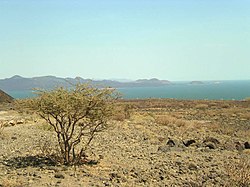Lake Turkana
Lake Turkana, formerly known as Lake Rudolf, is a lake in the Great Rift Valley in northwest Kenya. Its far northern end crosses into Ethiopia.[1]
| Lake Turkana Jade Sea | |
|---|---|
 | |
| Coordinates | 3°35′N 36°7′E / 3.583°N 36.117°E |
| Type | Saline, monomictic, alkaline, endorheic |
| Primary inflows | Omo River, Turkwel River, Kerio River |
| Primary outflows | Evaporation |
| Catchment area | 130,860 km² |
| Basin countries | Ethiopia, Kenya |
| Max. length | 290 km |
| Max. width | 32 km (20 mi) |
| Surface area | 6,405 km2 (2,473 sq mi) |
| Average depth | 30.2 m |
| Max. depth | 109 m |
| Water volume | 203.6 km³ |
| Surface elevation | 360.4 m |


It is the world's largest permanent desert lake and the world's largest alkaline lake. By volume it is the world's fourth-largest salt lake after the Caspian Sea, Issyk-Kul Lake and the (shrinking) Aral Sea. Among all lakes, it ranks 24th in area.
The water is drinkable, but not palatable. It supports a rich lacustrine wildlife. The climate is hot and very dry.
The rocks of the surrounding area are predominantly volcanic. Central Island is an active volcano, emitting vapors. Outcrops and rocky shores are found on the East and South shores of the lake, while dunes, spits and flats are on the West and North, at a lower elevation.
On-shore and off-shore winds can be extremely strong as the lake warms and cools more slowly than the land. Sudden, violent storms are frequent. Three rivers (the Omo, Turkwel and Kerio) flow into the lake, but lacking outflow, its only water loss is by evaporation. Lake volume and dimensions are variable. For example, its level fell by 10 meters (33 ft) between 1975 and 1993.[2]
Due to temperature, aridity and geographic inaccessibility, the lake retains its wild character. Many Nile crocodiles are on the flats. The rocky shores are home to scorpions and carpet vipers. Although the lake and its environs have been popular for expeditions of every sort under the tutelage of guides, rangers and experienced persons, they certainly must be considered hazardous for unguided tourists.
Lake Turkana National Parks are listed as a UNESCO World Heritage Site. Sibiloi National Park lies on the lake's eastern shore, while Central Island National Park and South Island National Park are in the lake. Both have crocodiles.
The Lake Turkana area is regarded by many anthropologists as the cradle of humankind because there are many hominid fossils. The skeleton of Turkana boy was found near the lake in 1984.
References
change- ↑ The boundary between Ethiopia and Kenya has been a contentious rational distinction. A brief consideration of the topic can be found in the State Department document, Ethiopia - Kenya Boundary Archived 2009-03-18 at the Wayback Machine
- ↑ Historic lake levels are graphed in the World Lakes Database Archived 2004-12-26 at the Wayback Machine.